This post discusses paracord knots and how to use them in paracord projects. Learning basic paracord knots can open up an entire paracord hobby, and you can find large groups of paracord enthusiasts.
Some people have turned the construction of paracord bracelets, necklaces, lanyards, etc., into a source of income.
Regardless of how serious you become about paracord projects, there is an infinite number of projects that can provide a fun and productive way to spend your time.
Tip: Check profit from various paracord projects if you want to learn how to make cool emergency gear out of paracord.
Table of contents
Paracord Supplies
Below are a few Paracord supplies to get you started.
There are several skills you gain from working with paracord.
- Working with your hands
- Hand-eye coordination
- Attention to detail
- Practice makes Perfect
- Patience is a virtue
Why Use Paracord?
Paracord is durable, cheap, and convenient when you need an extra piece of rope. Paracord projects are made to be unraveled and used for other purposes when needed.
This is one of the reasons paracord projects are so popular among outdoors people and survivalists. They are multi-purpose.
Paracord is a cheap and durable multi-tool that you can use everywhere from your house to the backcountry. Unfortunately, many people skip paracord to buy more expensive cords like bungee and ratchet straps.
Other cords have their uses but they add extra weight to your backpack. Plus, you can’t use them in the way you can use paracord. Paracord is more than friendship bracelets and friendly lanyards. It is a versatile cord that can get you out of trouble and it is less expensive than other types of cordage on the market.
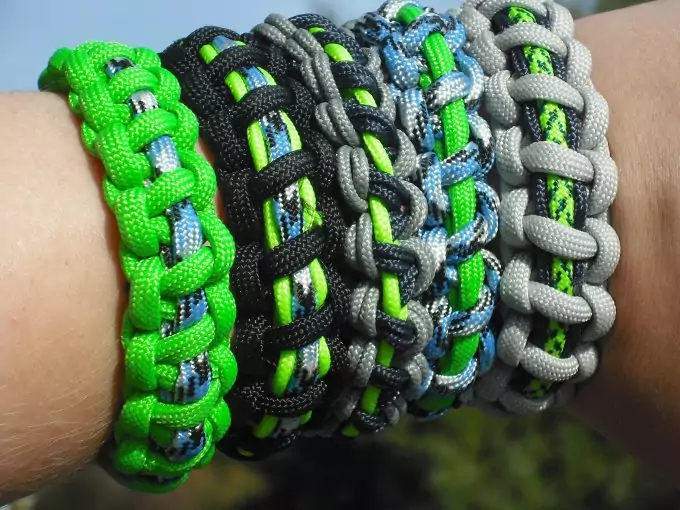
Paracord knots are what give the cord power. A good knot is easy and quick to tie and untie. The paracord should be easy to weave and even easier to unravel.
If you’ve never dealt with knots and braiding, you have no idea how many different knots and braiding styles are available. We’re going to talk about a few techniques and paracord knots you can begin with, but first, we are going to go over a few common mistakes.
Common Mistakes Beginners Make
Every beginner makes mistakes. This is normal, and the best way to learn. A few common mistakes are listed below, so you can be aware of them when you first begin working with paracord.
- Research is important before you start working with paracord. This “Field Guide for Knots” can help you get started. Learning about paracord projects before you start will save you time and money.
- Ending with the wrong kind of knot. Every paracord project ends with a knot to keep it in place. If you want to unravel the paracord you simply untie the knot. Most beginners end with the overhand knot, which is the most common type of knot and everyone knows how to do it. This is a good starting knot but plan to move to the lanyard knot as quickly as possible.
- Melting the ends too much is common. In order to keep the paracord from unraveling after you cut it, you need to melt the ends. If you’re new to this you might use too much heat and set the paracord on fire. You’ll get used to melting the ends in a more efficient manner over time but for the first projects use a butane torch lighter and try to not set the paracord on fire.
- Not getting the length right is a frequent mistake for beginners. It’s hard to approximate the correct length of paracord initially. You’re going to have either too much or too little. Either way it is going to be frustrating. You’ll learn to approximate with experience.
- Melting two ends together when combining colors is something you need to practice. When you melt two different colored pieces together you have to press the melting place with your fingers. If the nylon hardens you’ll end up with a rough part that will hurt your skin every time it touches it.
- Buying paracord in small amounts is expensive. If you decided you are serious about paracord projects then buy in bulk. Is costs much less.
- Paracord knots are important so make sure that you learn how to make them first. Once you have learned knots than you can move on to paracord projects.
Now that we’ve talked about common mistakes, lets’ move on to the following knots.
- Cobra Knot
- Lanyard Knot
- Snake Knot
- King Cobra Knot
- Trilobite Knot
- Monkey Fist Knot
Learning How to Make Paracord Knots
There are tutorials and guides on the internet that show you how to make paracord knots. Study the tutorials and guides and keep making knots until you become proficient. Practice is how you are going to become good.
Type #1 – The Cobra Knot
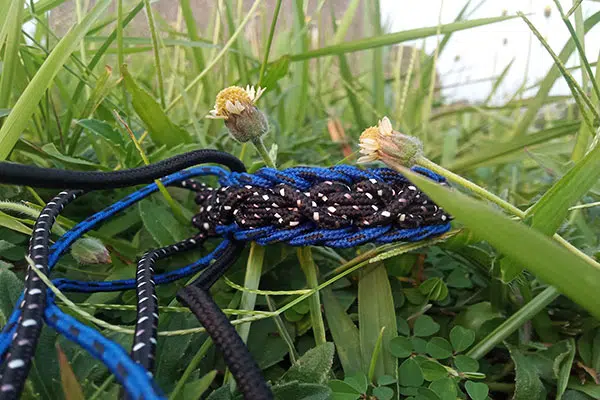
This is one of the first paracord knots you are going to learn. As you can see in the image above, you will need two strings of paracord to make this knot. The technique is simple:
- Hold both strings with your fingers and make sure they are straight alongside each other.
- Take the left cord and form a loop while putting the rest of the cord behind the two main strings.
- The right part goes under the left string and back over where it goes through the loop you formed with the left string.
- Tighten the knot.
To make sure you understand the technique see the video tutorial below. The video covers making the bracelet so go to minute 5.3 to see the knot. If you want to review making bracelets you can read how to make a paracord bracelet.
Type #2 – The Lanyard & Overhand Knots
As mentioned earlier, the Lanyard knot and Overhand knots are some of the easier knots. The Overhand knot is simple and easy to learn. Make a loop and pass the strings’ end through the loop. It’s called the overhand knot because you usually make the loop using two fingers or your entire hand.

The Lanyard knot is a bit more complicated and requires more attention and skill. The result looks better, though, and it will hold better than the Overhand knot. Review the technique below.
- Bend your section of paracord and put your two middle fingers through the loop at the end.
- Make a loop with the right end and lay it over the left end in your palm.
- Take the left end, go underneath the right end and put it through the loop in your palm making sure the string goes over the loop and underneath itself. You are going to end up with a shape that looks like the number eight with a diamond in the center, in your palm.
- The next step is to take each end and bring them around counterclockwise and put them through the diamond shape in the middle.
At this point, you can start tightening up your knot. Then, you can arrange it with your fingers, so it doesn’t look messy and out of shape. The tutorial below provides even more clarity on the knot.
This paracord knot may be a little harder for a beginner but you will learn it with practice. This knot is called a stopper knot because it is used in paracord projects like bracelets or bars.
Type #3 – The Snake Knot
This type of weaving is more intricate, but the result looks sharp, especially when using two different colors.
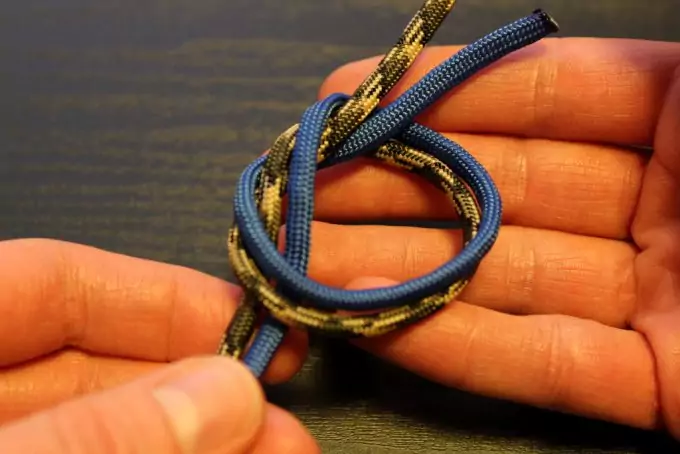
The Snake knot pattern looks like the scales of a snake wrapped around your wrist. Besides survival purposes, this knot is also decorative.
The technique for this knot is found below.
- If you’re using two different colors (recommended if you want the result to look even sharper) melt them together and bend the resulting piece of paracord at the melting point. If you’re using only one string bend it in half.
- Make the original loop, the one you will use to connect the two ends of your paracord bracelet together. Tie the loop tight with a knot.
- After you create the first loop, you want to loosen the base knot a little bit and take the opposite string and pass it through. Tight the knot again.
- Turn the entire thing over and you can see there is one end with two loops and one end with just one loop. Loosen the knot on the side with just one loop and pull through the opposite string.
- Turn the bracelet over and continue weaving in the same manner.
Below is a video tutorial on how to make the snake knot.
The basic concept of this knot is pulling the ends through a loop, similar to what is shown in the tutorial above.
Type #4 – The King Cobra Knot
This knot is actually very similar to the Cobra Knot until you get to the end.
The only difference is in the final result. The weaving is the same, but you take your old Cobra project and weave another one on top of it to obtain a King Cobra weaving pattern. If you use different colors, your final project will look much better.
Below is a video tutorial on how to make a King Cobra bracelet starting with a Cobra.
We included this knot in the list so you understand the difference between the Cobra and the King Cobra.
Type #5 – The Paracord Trilobite Knot
This type of weaving allows you to include more paracord in one project. The paracord knots used to make it are very similar to braiding using four strings.
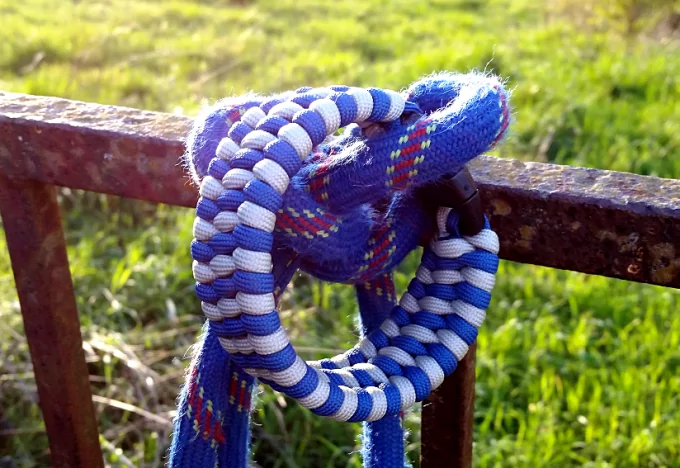
If you want your project to look good it is recommended you use two different colors. For this project, you’ll need two separate strings of paracord, each of them bent in half.
The technique is simple:
- Hang the two pieces of paracord on a nail or on a hook and make sure they are equal in size
- Use the two middle strings as the core and the two exterior strings to weave the projects
- Each one of the exterior strings goes around the nearest string first and then under or over the two main strings
Type #6 – The Monkey Fist Knot
The Monkey Fist is the beginning of the big leagues for paracord projects. If you want to continue, you should consider checking out this guide.
The Monkey Fist knot is both a decorative knot and a useful knot. You can use this type of knot as a decorative knot and for self-defense if you make it larger. However, this type of knot is a bit trickier to make and requires a few special items.
- 1 small, heavy ball (golf ball, 1 inch ball, etc)
- A needle to be able to weave the paracord
When you use this knot for self-defense, it is recommended you use a heavier, ball so you can hit an attacker with power and inflict stopping pain.
Because the technique is complicated and needs excellent paracord skills, you should check our tutorial on doing a monkey fist knot using paracord. You can also see explanations in the video below.
It is not something a beginner can do easily, but if you decide to try then this is what the result should look like.
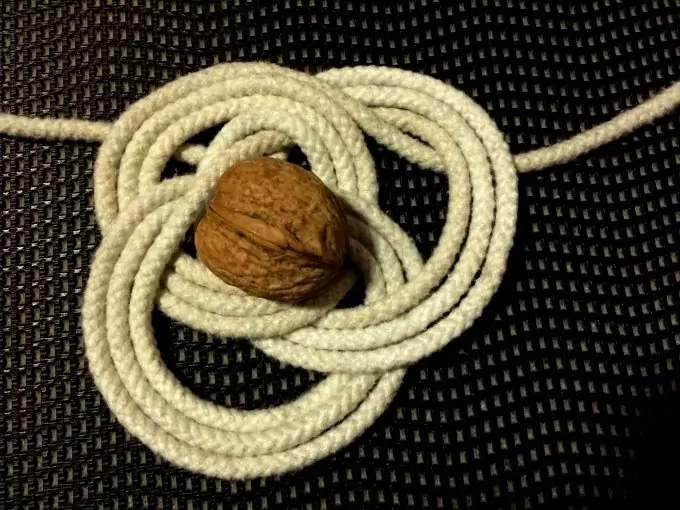
Paracord Knots
The paracord knots described above are only a few of the knots you can make. There are plenty of guides online, along with videos and other tutorials.
Learning how to make paracord knots and projects is not only fun, but it is also useful. There are numerous uses for paracord projects from gun slings to lanyards. Elaborate weaves are also quite decorative and require skill.
If you are just beginning then consider purchasing a guide or buying a kit that will provide the materials you need for your first project. You will find paracord projects very rewarding.
Paracord Knot Kits & Supplies
| Title | Price | |
|---|---|---|
 | MONOBIN Paracord, 550 Paracord Combo Kit | Check Price |
 | WEREWOLVES 550 Paracord Type III | Check Price |
 | Vankcp 56Pcs 28 Color 10 Ft Paracord Cord 550 | Check Price |
 | MONOBIN Paracord Combo Kits - 550 Type III Parachute Cord | Check Price |

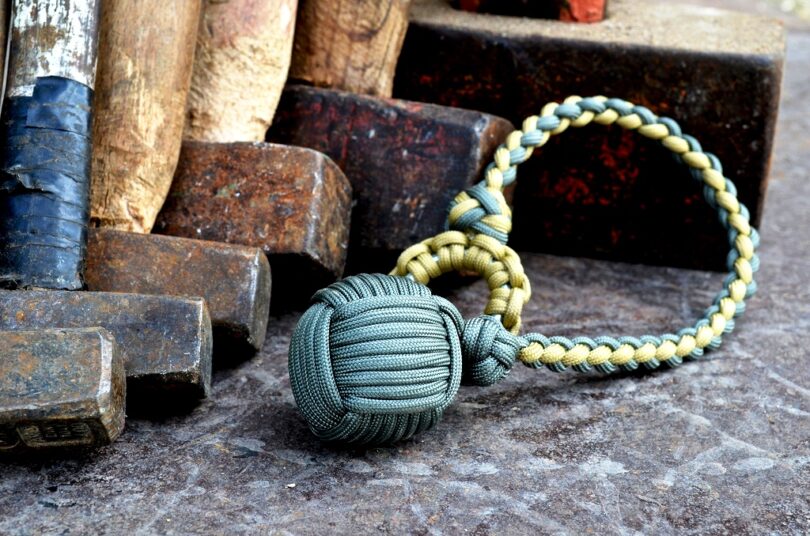







It doesn’t take that long to master these skills, and the reward is high. I started practicing a few months ago, and I was surprised with the results and the skills I developed. It’s about patience and it benefits other aspects of your personality as well.
That’s true Ben, especially when you consider all the things you can do with the paracord.
The building blocks of any paracord use/project are the paracord knots. Every project will get easier as you master the required knots. Practice make perfect, remember!
Knowing how to manipulate with paracord is awesome. I saw pictures of people doing crazy stuff out of paracord, like rescuing a stray care.
Learning to use paracord in different ways is fund and useful!
Thank you Rodney for sharing your opinion with us.
Indeed, Paracord is amazing stuff. There is so much that you can do with it. In actual fact, there are numerous projects that people have essentially implemented in survival situations. The knots provided in this posting should help you with the most important Paracord uses, such as a bracelet and a rifle sling.
After a long time, I just understand it today, I have been testing it for some time and I am pleased to know that wonder to know that it was that simple as it is very consistent and repeatable. The most important thing is that it turns out to be the same every time.Thanks a lot!
I never knew paracord knots were that simple. I have a friend who made a paracord rifle sling which was not only comfortable but also looks beautiful. I am surely going to try that myself.
You should try out the project, Mike. In actual fact, a paracord rifle sling is one of the easiest projects for a beginner.
All the knots are great. However, the monkey fist knot seems to be a great asset for my style. Is there a way, I can put a stone inside it to make it a deadlier weapon?
All you need are the basics, then you can modify the knot.
If you’re new to tying a monkey fist, it will probably take a few tries before you get it. You must be patient, especially when tightening the fist. Work slowly to tighten the strands from the center of your string out to one end, then repeat from center to opposite end to keep your strings even. Then you can incorporate a stone.
Outdoor enthusiasts have adopted the processes of paracord products making as a hobby and a profitable venture. It is a recreational medium but the techniques are stressful and difficult to a beginner who has to learn it diligently and patiently. However, there are several types of paracord knots that you can learn and practice regularly to become perfect. You can begin with the simple types like paracord bracelet as this will help you to display your craftsmanship projects with glee. Are you ready to start making money through your hobby?
Talking from experience, paracord knots are the building blocks of any paracord project. If you are new to paracord projects, then this article is the best place to start.
Are there advantages of using one braiding technique over another? Because during emergency situations, especially life threatening ones, you must be able to unwind your paracord as fast as possible. Or are all these braiding techniques the same in that regard and just the aesthetic that changes?
There are numerous paracord knots and projects. However, how easy you can untie the paracord depends on the project. Most survival projects are easy to unwind, including a paracord bracelet and a paracord grenade.
Paraord is such a versatile material and there are a lot of braiding techniques you can learn. Not only does it look cool but it also has a lot of functionality and even lasts a long time since it is water and mildew resistant.
There are a lot of styles in paracord braiding. You can find the pattern that you are most comfortable in making but you should also learn other patterns because some patterns are more suitable for bracelets, some for handles of knives and some for paracord lanyards.
The Paracord is a very resourceful material, which is strong, durable, lightweight, water and mildew resistant. You can effectively use Paracord if you know the various Paracord knots, which are the building blocks of Paracord projects.
Paracord knots and patterns are important skills to learn. You can make different gears, including survival kit, Paracord grenade, Paracord lanyard, tarp tie down, DIY hammock, and tow lines to mention a few.
Good article. I wrote an article with the same idea, but yours is better. Thanks a lot.
We are glad our content has been helpful to you, please look out for new postings on Paracord projects.
Great post! I love how you broke down each knot with clear explanations and video demonstrations. It’s super helpful for beginners like me. Can’t wait to try these out on my next camping trip!